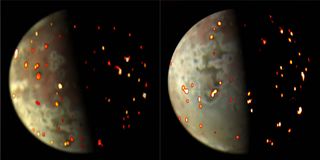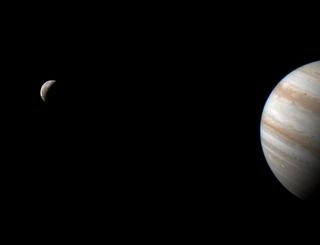See Jupiter's volcanic moon Io glow red-hot in incredible images from NASA's Juno probe
The Juno mission was making its 51st flyby of the gas giant planet and its moons when it viewed the 'tortured moon' Io in stunning detail.

NASA's Juno mission has made its 51st close flyby of Jupiter, catching stunning images of its moon Io, in the process.
Juno flew past Io on Tuesday, May 16, on a flyby that brought it closer to the volcanic moon of Jupiter than ever before. The spacecraft passed with just 22,060 miles (35,500 kilometers) of the Jovian moon's surface.
If this Jovian moon appears tranquil in these images (which NASA's Planetary Science Division released via Twitter on May 18), then appearances can be deceptive. Io isn't just the most volcanic moon orbiting the gas giant; it also happens to be the most volcanic world in the entire solar system.
Some of the detailed images taken by Juno and its visible light imager JunoCam show the Io's red-hued surface scarred by its fiery volcanoes. An infrared view of the moon captured earlier during a May 1 flyby by Juno's JIRAM (Jovian InfraRed Auroral Mapper) shows the source of this scarring, revealing multiple hotspots of volcanic activity over the surface of the moon.
Related: Io: A guide to Jupiter's volcanic moon

"Io is the most volcanic celestial body that we know of in our solar system," Juno principal investigator Scott Bolton said in a statement prior to the flyby. "By observing it over time on multiple passes, we can watch how the volcanoes vary — how often they erupt, how bright and hot they are, whether they are linked to a group or solo, and if the shape of the lava flow changes."

NASA estimates that there are hundreds of actively erupting volcanoes over the surface of Io, the third largest moon of Jupiter, and the fifth from the gas giant located at around at 262,000 miles (422,000 kilometers) from its surface. These volcanoes can blast lava dozens of miles into the thin water-less atmosphere of Io, which itself is around the size of Earth's moon.
Get the Space.com Newsletter
Breaking space news, the latest updates on rocket launches, skywatching events and more!

This extreme volcanic activity is believed to arise as a result of the tremendous gravitational influence of Jupiter, the most massive planet in the solar system, as it plays a game of "tug-of-war" with Io against its fellow large Jovian moons Europa and Ganymede. This gives rise to tremendous tidal forces that have the effect of squashing and squeezing Io, causing its surface to bulge up and down, or in and out, by as much as 330 feet (100 meters).
Even before the 51st flyby of Jupiter, since arriving at the gas giant in 2016, the Juno spacecraft had traveled over 510 million miles making close encounters with the three of the four largest moons of the planet, the icy moons Europa and Ganymede, and fiery moon Io. The four large moons, including frozen Callisto, are collectively known as the "Galilean moons" after Italian astronomer Galileo Galilei, who first observed them in 1610.
"We are entering into another amazing part of Juno's mission as we get closer and closer to Io with successive orbits. This 51st orbit will provide our closest look yet at this tortured moon," said Bolton. "Our upcoming flybys in July and October will bring us even closer, leading up to our twin flyby encounters with Io in December of this year and February of next year when we fly within 1,500 kilometers of its surface."
Juno wasn't actually designed to study these moons; rather, its instruments and sensors were intended to investigate Jupiter's atmosphere and interior. Yet despite this, during its 50 flybys of the gas giant, the NASA craft has been able to collect vital data about the Jovian moons and, as this flyby illustrates, some incredible images.
"All of these flybys are providing spectacular views of the volcanic activity of this amazing moon," Bolton concluded. "The data should be amazing."
Jupiter's large moons will be under further intense scrutiny when the JUpiter Icy Moon Explorer (JUICE) reaches them in 2031. Juice will search for the conditions on the ocean-bearing moons of Europa and Ganymede that would be needed to support the existence of life.
Editor's note: This story was updated at 5 p.m. on May 22 to indicate that the composite views of Io's volcanic activity in both visible and infrared were taken during a May 1 flyby.
Join our Space Forums to keep talking space on the latest missions, night sky and more! And if you have a news tip, correction or comment, let us know at: community@space.com.

Robert Lea is a science journalist in the U.K. whose articles have been published in Physics World, New Scientist, Astronomy Magazine, All About Space, Newsweek and ZME Science. He also writes about science communication for Elsevier and the European Journal of Physics. Rob holds a bachelor of science degree in physics and astronomy from the U.K.’s Open University. Follow him on Twitter @sciencef1rst.
-
Manasseh Kohath Earth is the only planet in the universe that has oxygen. You can only have fiery volcano's on Earth. Inorder to have fire you need oxygen. The writer needs to study more about science before he tries to write about nonfiction science. Maybe science fiction would be more suitable.Reply -
Estadio Not actually true... any element or compound with oxydizing capability can provide the same or similar characteristics to oxygen. https://www.scienceabc.com/nature/can-fire-occur-non-oxygenated-reaction.htmlReply -
Manasseh Kohath Your article said nothing about volcano's. The writer for this article said fiery volcano's. Hydrogen gases is what causes fire from a volcano. Hydrogen needs oxygen to burn. Flames from vents are hydrogen gas burning. Lava is not fire, it's molten rock. That's all that was seen from space. Ohhh yeah, there's no space aliens either in the universe. Only illegal aliens here on Earth.Reply
